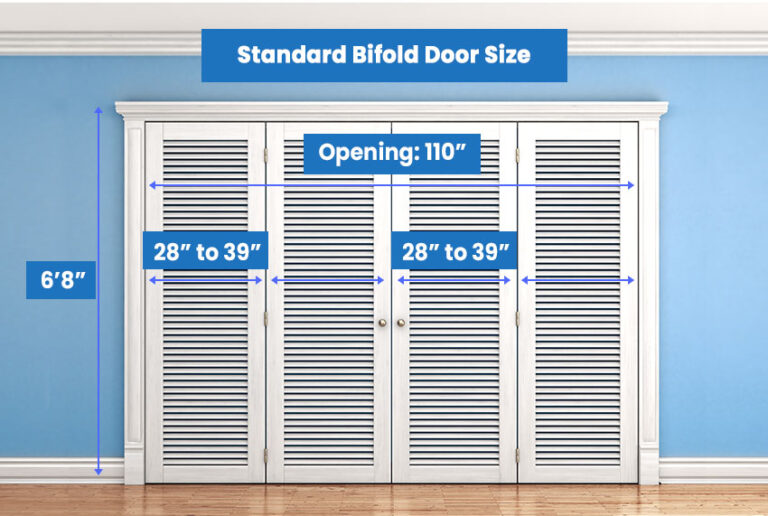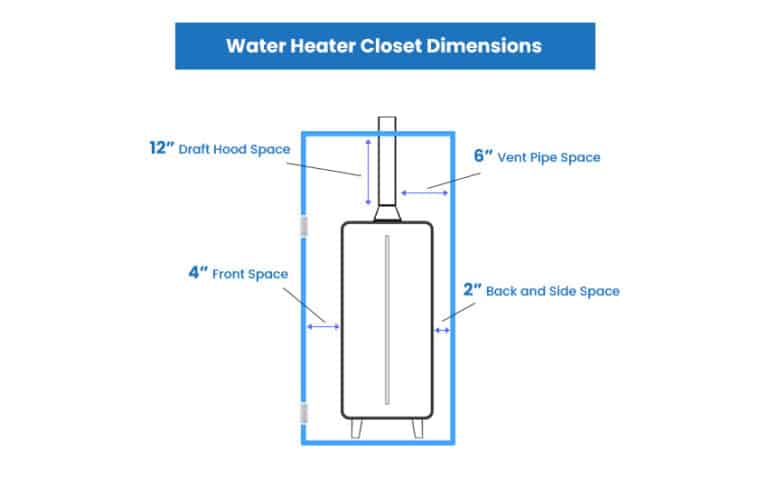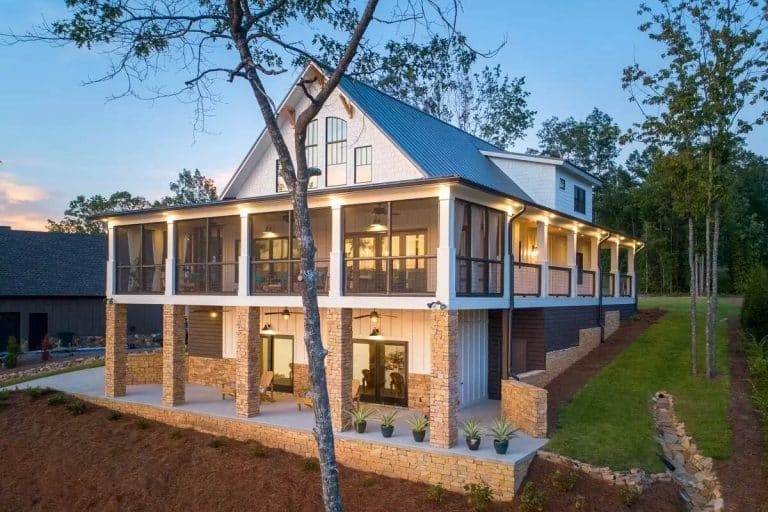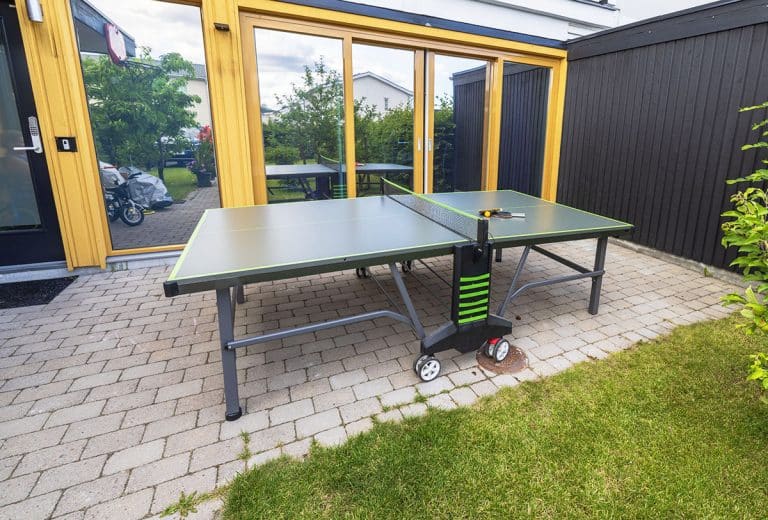What Size House Will Fit On My Lot?

Knowing what size house will fit on your lot is essential to designing a home or adding a second structure. Not only that, but often, regulations are associated with some purchased lots. Sometimes these regulations are based on local zoning policies, while some house-building projects will be affected by other aspects like infrastructure or adjacent buildings on the lot beside it.
It’s easy to calculate building coverage or space that will be needed for a specific home and lot size as long as the homeowners are aware of some numbers and factors. Other than the space coverage, there are other factors to consider, like adjacent blocks or streets that will affect elements like water and electricity or even road access.
Standard House Lot Size
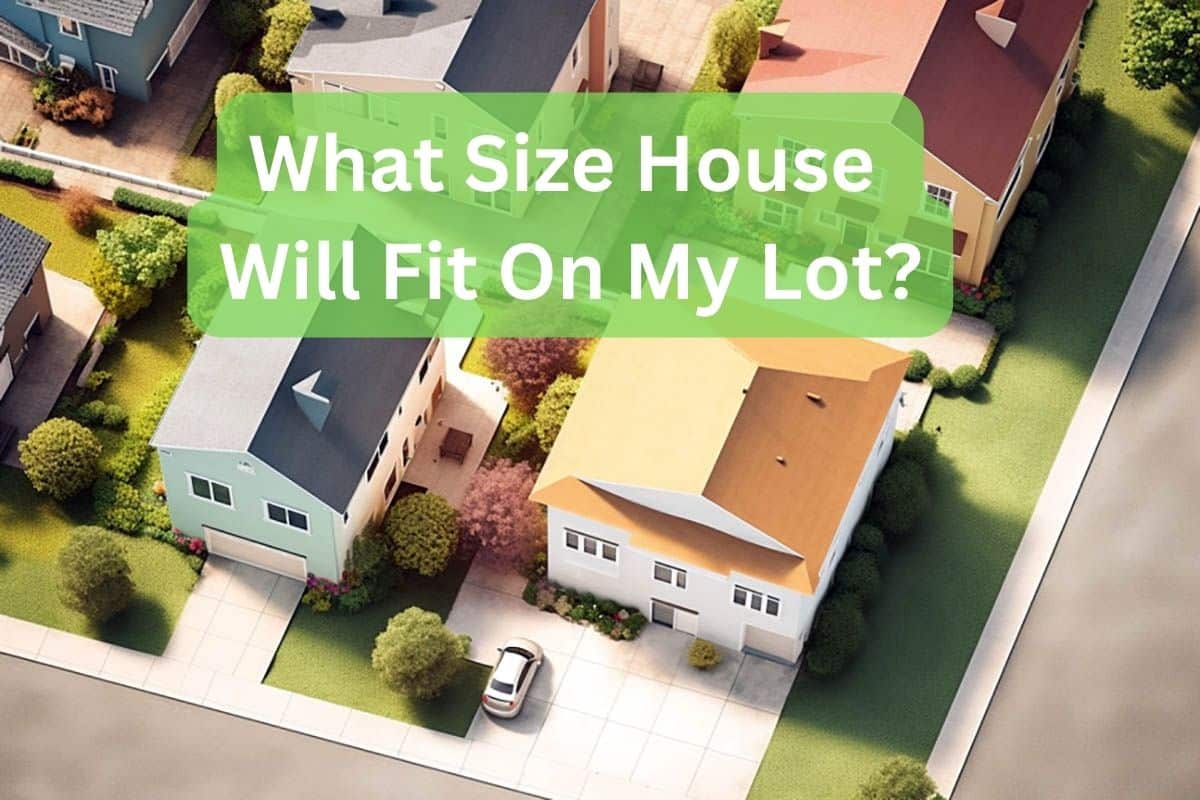
The standard lot size for a home today has an area of around 8177 square feet, which sees an 18% decline from the average size in 1992, which was 10,000 square feet. Today, smaller lots are more common owing to many factors, such as reduced priority on acreages and more pressing factors, such as land shortages.
This size will also vary from one region to the other according to how populated a state is in the other. A homeowner needs to know about these lot trends since they can easily connect these facts to their plans to buy or build a lot or a home, respectively.
Here’s the Recommended Lot Sizes for Different Home Sizes
• 1500 Square Foot House: A lot size of 4500 square feet, or .10 acres (418.1 square meters).
• 2000 Square Foot House: A 6000 sq ft parcel, or .14 acres (557.4 square meters).
• 2500 Square Foot House: A 7500 sq ft parcel, or .17 acres (696.8 square meters).
• 3000 Square Foot House: A 9000 sq ft parcel, or .21 acres (836.1 square meters).
• 3500 Square Foot House: A 10,500 sq ft parcel, or .24 acres (975.5 square meters).
(These calculations above use the FAR ratio of 3.0 to 1. More on this ratio below)
Lot Parcel Size vs House Size
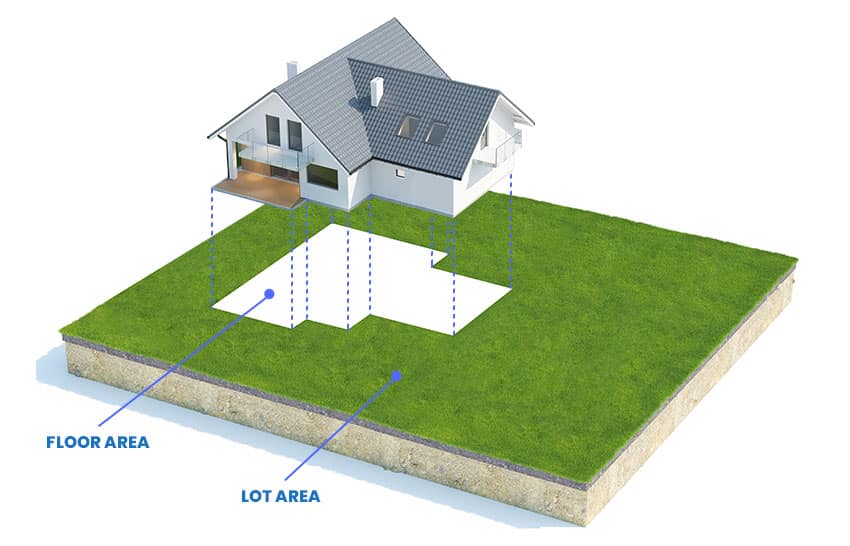
Aside from accessibility to the main highway, neighborhood situation, and infrastructure, there is also consideration like the home’s size and the lot parcel itself.
The lot and house size are two different things in these two size considerations. It also affects decision-making since sometimes, a question about whether to choose a more oversized lot or a bigger house is most suitable for different households with differing needs. This decision is based a lot on factors that are important to a particular homeowner.
The lot area of a particular property is the total area of the place itself, including the yard up to the property lines or boundaries. For the house size, the floor area is calculated, and that space is the room inside the building that is livable. The house size also includes the exterior walls.
To sum it up, house size includes bedroom and living room areas, and lot areas include the outside space for spaces like yards, walkways, driveways, and what have you.
How Big Is A Lot Location?
The lot size refers to the land size that a particular property is on. Often, it is represented in numbers in square feet or acres. There is no exact measurement for a specific lot because some can be small while some lots are large.
The average lot size in the United States today is about 8177 square feet or 760 square meters.
Finding your lot dimensions calls for measuring the entire parcel to know accurately how big or small it is. Also, sometimes, the parcel size is already indicated on the deed of sale of inheritance of a particular plot of land.
Knowing the size has many benefits, but one of them is knowing the measurements to make sure that money is well-spent for house plans and during construction. No homeowners want the frustration of building a house that is too big for the lot, doesn’t meet building regulations, and is too small to accommodate all their needs.
How To Determine What Size of House Will Fit On A Lot?
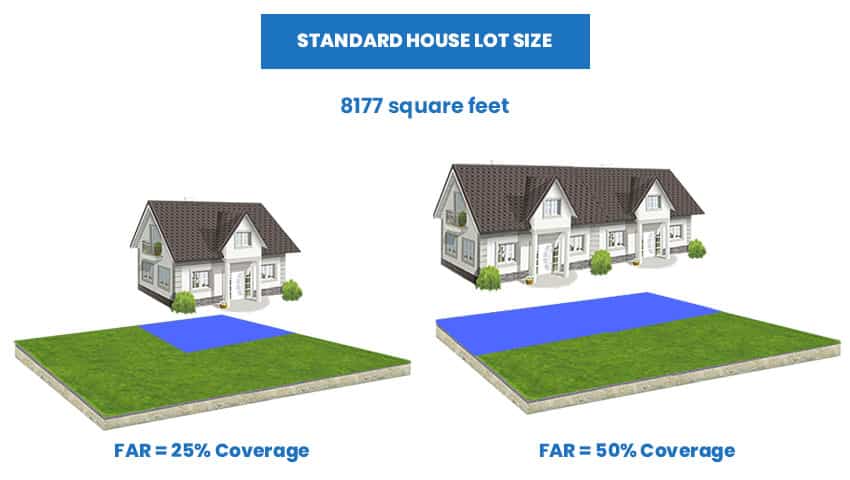
There are many factors in play to determine what house will fit a specific lot size. The first factor to consider is the building or site coverage.
This space will include all in-building structures like cantilevered extensions, garages, awnings, and what have you. The value of this coverage is usually conveyed in percentages and will express the green and built environment of a specific space.
The second factor is the building setback which dictates virtual space that should be left vacant in order for the space to be mindful of neighboring property lines and street requirements. There is a front setback to consider plus side and back values which is generally smaller than the former.
Other than that, this factor also considers space essential for utility easements, such as water connections, drains, and electricity lines.
Depending on what the homeowners are aiming for, it is a direct rule that the higher the floors of a house are, the smaller its footprint will be. One essential thing that also dictates height is the value of setbacks. This makes it so that fire trucks can access higher floors, especially in apartment complexes and buildings.
The next is the floor space index, also known as the floor area ratio (FAR). This factor will help control the neighborhood density and will be accessible locally. Read more about how to calculate FAR at Metrocouncil.org
As a general rule of thumb in the United States, the land-to-building ratio is 3 to 1. This means that when determining the square footage of your potential home, you should multiply this number by 3 to get the amount of land needed. For instance, a 1500 (square foot home) multiplied by 3 equals a 4500 square foot lot requirement.
Another factor is parking requisites, especially for bigger homes with more vehicles. The bigger the space allotted for parking will be, the smaller the building footprint will be, depending on specific lot dimensions.
The last factor is on-site utilities that keep the house running and functioning. This will include wells, septic tanks, gas pipes, etc. Sanitary concerns like how close septic tanks are to wells are essential to avoid cross-contamination. These factors decrease the usable building footprint of a specific parcel.
What Is A Good Size Lot For A Home?
The perfect lot sizes for homes will consider many factors, such as how big the budget is, how many family members are there, what they prioritize for home utilities, where they live, and many other factors.
Time is also a factor where the standard home and lot size have decreased due partly to land shortages and increased asking prices for many homes for sale.
The space available for a starter or apartment home for a single-child household decreased from 10,000 square feet in 1992 to a smaller 8177 square feet in 2019. Because of recent circumstances, more specifically, the COVID-19 pandemic, that number is expected to scrunch down soon to a humble 8000 square feet lot.
Minimum Lot Size for 1500 sq ft House
Many agree that a 1500-square-foot home is the best size since it sits right in the middle. To visualize a 1500-square-foot home, a homeowner should think of a space around one-third of a basketball court. In a 1500-square-foot house, the sides will measure around 40 feet.
It can fit four small-sized bedrooms stacked from one end to the other, with each space measuring around 10 by 10 feet. For bigger rooms, the homeowners could allot about two to three bedrooms for a 1500 square feet place.
Considering a FAR ratio of 1.25, the minimum lot size would be 1875 square feet for a 1500 square foot house. This space will also allow for the inclusion of a laundry or utility room outside the living, dining rooms, and kitchen. A FAR ratio of 1.5 would give you a lot size of 2250. Many would consider this amount of yard space quite small and this is why it is only the minimum.
Minimum Lot Size for 2000 sq ft House
A house of 2000 square feet is virtually equal to .045 acres of land. This home typically has the space to add rooms like a den or a bedroom with an attached bathroom as well as a closet. Media rooms and offices are also a usual addition to this house size.
In order to accommodate this house size, considerable land size is needed and will depend on what the homeowners are looking to have for their homes. Maybe they like a sizable garage for all their vehicles or are looking to make space to build a swimming pool for the children.
A lot size for a 2000 sq ft house with a FAR ratio of 1.25 should be about 2500 square feet or more. Ultimately, the space needed is adjustable to ensure that the floor space of 2,000 square feet is accommodated.
Minimum Lot Size For 2500 sq ft House
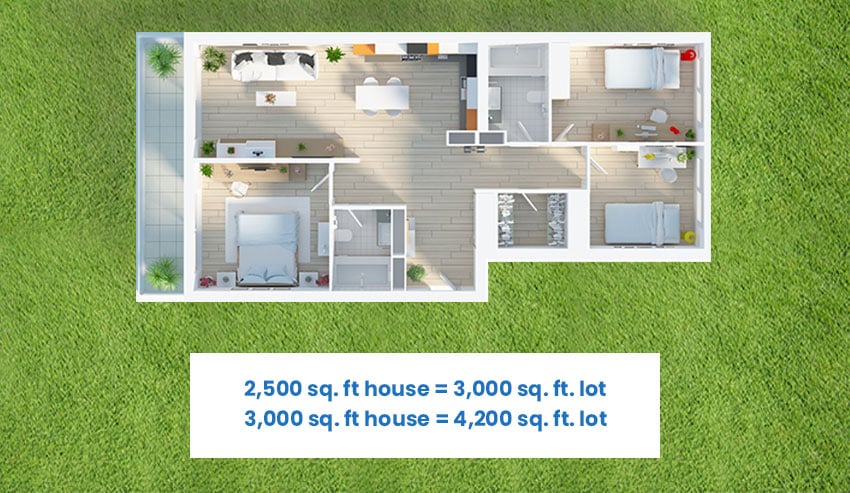
The space needed for a 2500-square-foot home will depend on the homeowner’s budget and building bylaws where they live. As expected and written by most laws, 1.25 FAR is expected from residential property.
For the land to be able to accommodate a home as big as 2500 square feet, roughly 3000 square feet of a lot is needed. This space will include considerations like utility requirements and others. It will give the homeowner space to build other home spaces like dens, a sizable backyard, or a multi-car garage.
For other lavish homes with added features, and if the homeowners have the budget for it, going up to 4,000 to 5,000 square feet of a lot will also give them the space to renovate.
Minimum Lot Size for 3000 sq ft House
Although there is a considerable 500 square feet difference between a 2500 square feet home and a 3000 square feet one, determining the lot size needed for this size will consider almost the same factors.
Lot size is a characteristic on which there seems to be no universal agreement. Many feel that small house lots are substandard and that anything under an acre is inadequate. On the other hand, a great many people feel that large lots require more care than owners wish to provide and that very satisfactory living conditions can be obtained from a well-planned small parcel. – Houses The Illustrated Guide to Construction, Design and Systems, 1998
The average lot size for this home size is around 4200 square feet. This number will increase according to a homeowner’s desire and requirements for their space.
Do they want room for more outside amenities like a den or a garage? Or are they looking to allot more constructible space for future home improvement projects? Ultimately, they should go up to an area of 4200 to 6000+ square feet if they have the money to accommodate for more outdoor enjoyment.
How Many Houses Can Fit On ¼ Acre?
1/4 acre of land, or .25 acres, is approximately 10890 square feet of land, of an acre, which is 43560 square feet. Although when compared to a full acre, a .25 acre does not look that tremendous, this space is still very much livable.
In this sizable land, homeowners can easily consider building 11 average-sized 941 square feet apartments to be rented out. A homeowner can also fit up to 4 homes in this land size, and they can go down to three if they want to have space between each house so that space can be utilized for other outdoor amenities like living rooms or pools.
How Many Homes Can You Build On 0.3 Acres?
If up to four houses can fit around 1/4 acre or .25 acre of land, going up to .3 acre won’t matter much. Still, it will ensure that each of the three houses will have more space for outdoor amenities or even give the homeowners considerable space to consider renovations to each home in the future. This size lot can also allow the building of up to a 14-unit apartment rental complex.
Any acreage added to a parcel, no matter how small, will add to the possibilities a homeowner can do to the space, especially if they have the budget to do so. However, local regulations must be followed before building to ensure compliance with local rules.
Amount Of Houses That Fit On Half An Acre?
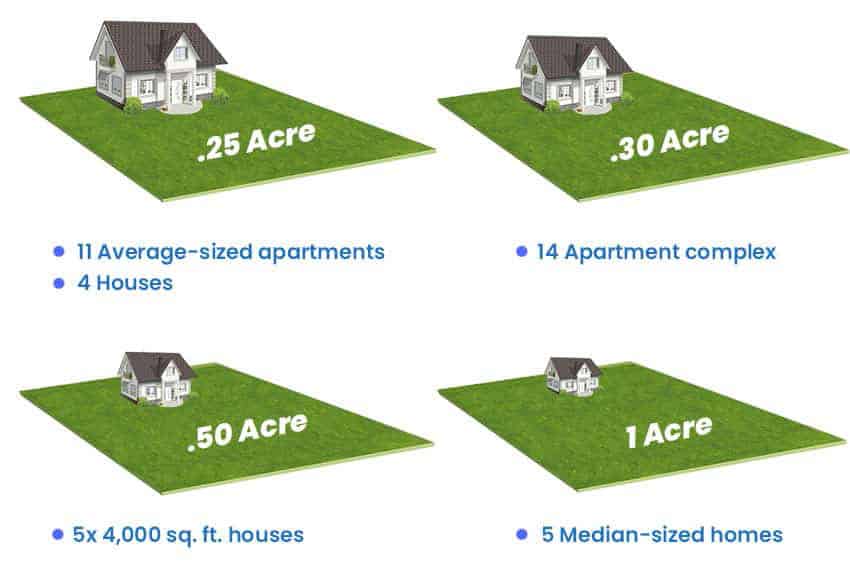
Half an acre is approximately half of 43560 square feet or about 21780 square feet of land—a jump from 1/4 acre. According to zoning laws in many places, homes that can be built on half an acre of land can range from none and up.
Up to 8 single family homes can be built at this location, with considerable spaces for outdoor amenities for all eight homes. If they want to make around 4000 square feet of house in this plot of land, up to 5 homes with a size of 4000 square feet can be built on half an acre.
How Many Homes Can Be Built On 1 Acre?
A 1 acre of land is 43560 square feet of usable space. This space is harder to visualize because, in a sense, it is too big. For homeowners looking to build on this land, there is a lot they can do with this.
Since the median home size is around 8276 square feet, it can fit up to 5 of it in an acre. Although this is an estimate, it is still essential to consult zoning laws since the number of houses that can be built in a certain space will vary from state to state.
What Size House Can I Build On Half An Acre?
Depending on what a homeowner envisions for their home plus what the zoning laws in a specific state or area, they can build up to 50 high-density multi-story homes in the area; if they are looking to build single-family detached homes, this number can be up to 8 houses built on half an acre of land. They can even build a mansion in this space, with lots of outdoor spaces.
Acreage Calculator Tool
To quickly help you determine the total acreage and square footage of your house lot, you can use the calculator below. You will need to add the length in feet, and the width in feet, for the calculator to share your lot size results, including its total acreage.
Visit our top 10 bedroom layout planner software for more related content.

